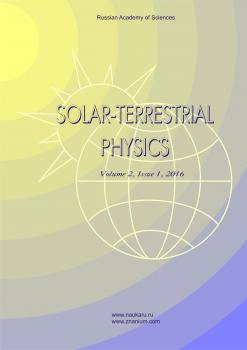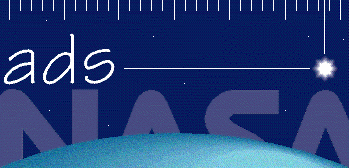Самарский филиал Физического института им. П.Н. Лебедева РАН
Самара, Россия
Государственный астрономический институт им. П.К. Штернберга
Москва, Россия
Самарский филиал Физического института им. П.Н. Лебедева РАН
Россия
Самарский национальный исследовательский университет им. академика С.П. Королева
Москва, Россия
УДК 523.9-739 Мягкое рентгеновское излучение и излучение в дальнем УФ-диапазоне
The paper presents the results of a study of capabilities of the SITES algorithm for reconstructing the differential emission measure (DEM) of a source from its radiation in several parts of the electromagnetic spectrum in the context of observing solar nanoflares with the AIA/SDO instrument. The SITES method was implemented in the Python programming language and was first used to construct the DEM of nanoflares. For this purpose, we tested the efficiency of the algorithm on model single- and double-peak DEM at characteristic temperatures of solar nanoflares. The test results indicate that the SITES algorithm can be of limited applicability for studying the DEM of nanoflares in the single-peak approximation. The algorithm has a combination of high accuracy and high counting rate in the studied temperature range from 1 to 3 MK. The features of DEM nanoflares reconstructed by the SITES method were examined using our previously found sample of 58855 events observed in 2019 with the AIA/SDO instrument. The results confirm that the characteristic plasma temperature in nanoflares is 1–2 MK. The reconstructed DEM of nanoflares generally have one maximum within this range, but the temperature distribution we obtained for all flares forms two clusters with maxima at 1.2 and 1.7 MK. We interpret this as possible evidence for the existence of two types of solar nanoflares, but this result requires further confirmation.
nanoflares, differential emission measure (DEM), quiet Sun
1. Aschwanden M.J., Parnell C.E. Nanoflare statistics from first principles: fractal geometry and temperature synthesis. Astrophys. J. 2002, vol. 572, no. 2, p. 1048. DOI:https://doi.org/10.1086/340385.
2. Aschwanden M.J., Tarbell T.D., Nightingale R.W., Wolfson C.J. Time variability of the “quiet” Sun observed with TRACE. II. Physical parameters, temperature evolution, and energetics of extreme-ultraviolet nanoflares. Astrophys. J. 2000, vol. 535, no. 2, p. 1047. DOI:https://doi.org/10.1086/308867.
3. Belov S.A., Bogachev S.A., Ledentsov L.S., Zavershinskii D.I. Solar nanoflares in different spectral ranges. Astron. Astrophys. 2023. Vol. 684. P. A60. DOI:https://doi.org/10.1051/0004-6361/202348199.
4. Benz A.O., Krucker S. Energy distribution of microevents in the quiet solar corona. Astrophys. J. 2002, vol. 568, no. 1, p. 413. DOI:https://doi.org/10.1086/338807.
5. Berghmans D., Clette F., Moses D. Quiet Sun EUV transient brightenings and turbulence. A panoramic view by EIT on board SOHO. Astron. Astrophys. 1998, vol. 336, рр. 1039–1055.
6. Bogachev S.A., Ulyanov A.S., Kirichenko A.S., Loboda I.P., Reva A.A. Microflares and nanoflares in the solar corona. Physics-Uspekhi. 2020, vol. 63, iss. 8, p. 783.
7. Cheng Zhang J., Saar S.H., Ding M.D. Differential emission measure analysis of multiple structural components of coronal mass ejections in the inner corona. Astrophys. J. 2012, vol. 761, no. 1, p. 62. DOI:https://doi.org/10.1088/0004-637X/761/1/62.
8. Chitta L.P., Peter H., Young P.R. Extreme-ultraviolet bursts and nanoflares in the quiet-Sun transition region and corona. Astron. Astrophys. 2021, vol. 647, p. A159. DOI:https://doi.org/10.1051/0004-6361/202039969.
9. Hannah I.G., Kontar E.P. Differential emission measures from the regularized inversion of Hinode and SDO data. Astron. Astrophys. 2012, vol. 539, p. A146. DOI:https://doi.org/10.1051/0004-6361/201117576.
10. Heinemann S.G., Heinemann S.G., Saqri, J., Veronig A.M., Hofmeister S.J., Temmer M. Statistical approach on differential emission measure of coronal holes using the CATCH catalog. Solar Phys. 2021, vol. 296, no. 18, pp. 1–17. DOI:https://doi.org/10.1007/s11207-020-01759-0.
11. Hudson H.S. Solar flares, microflares, nanoflares, and coronal heating. Solar Phys. 1991, vol. 133, pp. 357–369. DOI:https://doi.org/10.1007/BF00149894.
12. Joulin V., Buchlin E., Solomon J., Guennou C. Energetic characterisation and statistics of solar coronal brightenings // Astron. Astrophys. 2016, vol.. 591, pp. A148. DOI: 10.1051/ 0004-6361/201526254.
13. Krucker S., Benz A.O. Energy distribution of heating processes in the quiet solar corona. Astrophys. J. 1998, vol. 501, no. 2, p. L213. DOI:https://doi.org/10.1086/311474.
14. Lemen J.R., Title A.M., Akin D.J., Boerner P.F., Chou C., Drake J.F., et al. The Atmospheric Imaging Assembly (AIA) on the Solar Dynamics Observatory (SDO). Solar Phys. 2012, vol. 275, pp. 17–40. DOI: 10.1007/ s11207-011-9776-8.
15. Massa P., Gordon Emslie A., Hannah I.G., Kontar E.P. Robust construction of differential emission measure profiles using a regularized maximum likelihood method. Astron. Astrophys. 2023, vol. 672. DOI:https://doi.org/10.1051/0004-6361/202345883.
16. Morgan H., Pickering J. Sites: Solar iterative temperature emission solver for differential emission measure inversion of EUV observations. Solar Phys. 2019, vol. 294, no. 135, p. 135. DOI:https://doi.org/10.1007/s11207-019-1525-4.
17. Parker E.N. Nanoflares and the solar X-ray corona. Astrophys. J. 1988, vol. 330, рр. 474–479. DOI:https://doi.org/10.1086/166485.
18. Purkhart S., Veronig A.M. Nanoflare distributions over solar cycle 24 based on SDO/AIA differential emission measure observations. Astron. Astrophys. 2022, vol. 661, p. A149. DOI:https://doi.org/10.1051/0004-6361/202243234.
19. Ulyanov A.S., Bogachev S.A., Reva A.A., Kirichenko A.S., Loboda I.P. The energy distribution of nanoflares at the minimum and rising phase of solar cycle 24. Astron. Lett. 2019. Vol. 45, no. 4. P. 248–257. DOI:https://doi.org/10.1134/S1063773719040078.
20. Van Doorsselaere T., Srivastava A.K., Antolin P., Magyar N., Farahani S.V., Hui Tian, et al. Coronal heating by MHD waves. Space Sci. Rev. 2020, vol. 216, no. 140, pp. 1–40. DOI:https://doi.org/10.1007/s11214-020-00770-y.
21. Vanninathan K., Veronig A.M., Dissauer K., Madjarska M.S., Hannah I.G., Kontar E.P. Coronal response to an EUV wave from DEM analysis. Astrophys. J. 2015, vol. 812, no. 2, p. 173. DOI:https://doi.org/10.1088/0004-637X/812/2/173.



















